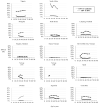Age-specific human papillomavirus antibody and deoxyribonucleic acid prevalence: a global review
- PMID: 22265107
- PMCID: PMC3572199
- DOI: 10.1016/j.jadohealth.2011.10.010
Age-specific human papillomavirus antibody and deoxyribonucleic acid prevalence: a global review
Abstract
Purpose: Global data on human papillomavirus (HPV) serological and deoxyribonucleic acid (DNA) prevalence are essential to optimize HPV prophylactic vaccination strategies.
Methods: We conducted a global review of age-specific HPV antibody and studies with both antibody and DNA prevalence for HPV-16, -18, -6, and -11.
Results: One hundred seventeen studies were included; participants' ages ranged from several hours to >90 years. HPV-16 seroprevalence was generally higher in Africa, Central and South America, and North America, more prevalent among women than among men, and peaked around ages 25-40 years. HPV-18 seroprevalence was generally lower than HPV-16 with a later age peak. Data were limited for HPV-6 and -11, both of which peaked at ages similar to HPV-18. Among 9-26-year-old females, HPV-16 seroprevalence ranged from 0%-31% in North America, 21%-30% in Africa, 0%-23% in Asia/Australia, 0%-33% in Europe, and 13%-43% in Central and South America. HPV-16/-18 DNA prevalence peaked 10-15 years before corresponding HPV-16/-18 antibody prevalence.
Conclusions: Females within the HPV vaccine-eligible age-group (9-26 years) had a range of dual HPV-16 DNA and serology negativity from 81%-87%, whereas 90%-98% were HPV-16 DNA negative. Serology and DNA data are lacking worldwide for females younger than age 15 years, the prime target group for vaccination.
Copyright © 2012 Society for Adolescent Health and Medicine. Published by Elsevier Inc. All rights reserved.
Figures


References
-
- Human Papillomaviruses . IARC Monographs on the Evaluation of Carcinogenic Risks to Humans. International Agency for Research on Cancer (IARC); Lyon, France: 2007.
-
- Ferlay J, Shin HR, Bray F, et al. Estimates of worldwide cancer burden in 2008: GLOBOCAN 2008. Int J Cancer. 2010;127(12):2893–917. DOI: 10.1002/ijc.25516. - PubMed
-
- Harper DM, Franco EL, Wheeler C, et al. Efficacy of a bivalent L1 virus-like particle vaccine in prevention of infection with human papillomavirus types 16 and 18 in young women: a randomised controlled trial. Lancet. 2004;364:1757–65. DOI: 10.1016/S0140-6736(04)17398-4. - PubMed
-
- Group TFIS Quadrivalent vaccine against human papillomavirus to prevent high-grade cervical lesions. N Engl J Med. 2007;356:1915–27. DOI:10.1056/NEJMoa061741. - PubMed
Publication types
MeSH terms
Substances
Grants and funding
LinkOut - more resources
Full Text Sources
Medical

